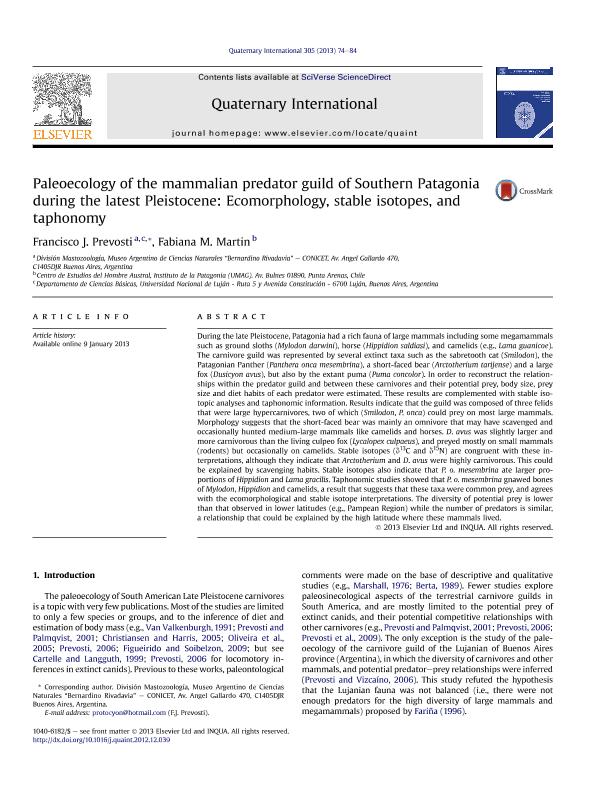Mostrar el registro sencillo del ítem
dc.contributor.author
Prevosti, Francisco Juan

dc.contributor.author
Martin, Fabiana Maria

dc.date.available
2019-09-26T15:38:40Z
dc.date.issued
2013-08
dc.identifier.citation
Prevosti, Francisco Juan; Martin, Fabiana Maria; Paleoecology of the mammalian predator guild of Southern Patagonia during the latest Pleistocene: Ecomorphology, stable isotopes, and taphonomy; Pergamon-Elsevier Science Ltd; Quaternary International; 305; 8-2013; 74-84
dc.identifier.issn
1040-6182
dc.identifier.uri
http://hdl.handle.net/11336/84524
dc.description.abstract
During the late Pleistocene, Patagonia had a rich fauna of large mammals including some megamammals such as ground sloths (Mylodon darwini), horse (Hippidion saldiasi), and camelids (e.g., Lama guanicoe). The carnivore guild was represented by several extinct taxa such as the sabretooth cat (Smilodon), the Patagonian Panther (Panthera onca mesembrina), a short-faced bear (Arctotherium tarijense) and a large fox (Dusicyon avus), but also by the extant puma (Puma concolor). In order to reconstruct the relationships within the predator guild and between these carnivores and their potential prey, body size, prey size and diet habits of each predator were estimated. These results are complemented with stable isotopic analyses and taphonomic information. Results indicate that the guild was composed of three felids that were large hypercarnivores, two of which (Smilodon, P. onca) could prey on most large mammals. Morphology suggests that the short-faced bear was mainly an omnivore that may have scavenged and occasionally hunted medium-large mammals like camelids and horses. D. avus was slightly larger and more carnivorous than the living culpeo fox (Lycalopex culpaeus), and preyed mostly on small mammals (rodents) but occasionally on camelids. Stable isotopes (δ13C and δ15N) are congruent with these interpretations, although they indicate that Arctotherium and D. avus were highly carnivorous. This could be explained by scavenging habits. Stable isotopes also indicate that P. o. mesembrina ate larger proportions of Hippidion and Lama gracilis. Taphonomic studies showed that P. o. mensembrina gnawed bones of Mylodon, Hippidion and camelids, a result that suggests that these taxa were common prey, and agrees with the ecomorphological and stable isotope interpretations. The diversity of potential prey is lower than that observed in lower latitudes (e.g., Pampean Region) while the number of predators is similar, a relationship that could be explained by the high latitude where these mammals lived.
dc.format
application/pdf
dc.language.iso
eng
dc.publisher
Pergamon-Elsevier Science Ltd

dc.rights
info:eu-repo/semantics/openAccess
dc.rights.uri
https://creativecommons.org/licenses/by-nc-nd/2.5/ar/
dc.subject
Carnivora
dc.subject
Paleoecología
dc.subject
Patagonia
dc.subject
Cuaternario
dc.subject.classification
Otras Ciencias Naturales y Exactas

dc.subject.classification
Otras Ciencias Naturales y Exactas

dc.subject.classification
CIENCIAS NATURALES Y EXACTAS

dc.title
Paleoecology of the mammalian predator guild of Southern Patagonia during the latest Pleistocene: Ecomorphology, stable isotopes, and taphonomy
dc.type
info:eu-repo/semantics/article
dc.type
info:ar-repo/semantics/artículo
dc.type
info:eu-repo/semantics/publishedVersion
dc.date.updated
2019-09-24T12:53:28Z
dc.journal.volume
305
dc.journal.pagination
74-84
dc.journal.pais
Estados Unidos

dc.description.fil
Fil: Prevosti, Francisco Juan. Consejo Nacional de Investigaciones Científicas y Técnicas. Oficina de Coordinación Administrativa Parque Centenario. Museo Argentino de Ciencias Naturales “Bernardino Rivadavia”; Argentina. Universidad Nacional de Luján. Departamento de Ciencias Básicas; Argentina
dc.description.fil
Fil: Martin, Fabiana Maria. Instituto de la Patagonia; Chile
dc.journal.title
Quaternary International

dc.relation.alternativeid
info:eu-repo/semantics/altIdentifier/url/https://www.sciencedirect.com/science/article/pii/S1040618213000049
dc.relation.alternativeid
info:eu-repo/semantics/altIdentifier/doi/http://dx.doi.org/10.1016/j.quaint.2012.12.039
Archivos asociados
